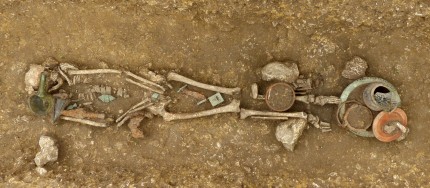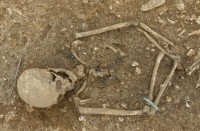 Archaeologists have unearthed 300 intact Merovingian-era graves at Saint-Aubin-des-Champs in the Calvados region of Lower Normandy. The presence of a necropolis on the site was first recognized during a preliminary survey last year in anticipation of construction of a housing development. Excavations began this March. They found the cemetery was complete — the enclosure delineating the full perimeter of the grounds was identified — and undisturbed with 300 burials of men, women and children from the 5th through the 7th centuries.
Archaeologists have unearthed 300 intact Merovingian-era graves at Saint-Aubin-des-Champs in the Calvados region of Lower Normandy. The presence of a necropolis on the site was first recognized during a preliminary survey last year in anticipation of construction of a housing development. Excavations began this March. They found the cemetery was complete — the enclosure delineating the full perimeter of the grounds was identified — and undisturbed with 300 burials of men, women and children from the 5th through the 7th centuries.
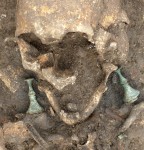 The burials were found at different depths up to five feet below the surface. The deceased were buried in wooden coffins (all of them now decayed into nothingness leaving only the shape behind) and almost all of the graves contain the remains of clothing and some artifacts. A third of the burials contain a particularly rich array of grave goods. These date to the 5th century, as identified by the artifacts.
The burials were found at different depths up to five feet below the surface. The deceased were buried in wooden coffins (all of them now decayed into nothingness leaving only the shape behind) and almost all of the graves contain the remains of clothing and some artifacts. A third of the burials contain a particularly rich array of grave goods. These date to the 5th century, as identified by the artifacts.
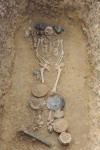 One burial stands out for its fabulous accouterments. The skeleton of adult male was found buried with 20 objects, among them ceramic vessels, glassware, a bronze bowl, an intact wooden bucket with bronze strapping, an axe, a spear, a dagger at his waist, shoes on his feet and a silver coin in his mouth. The later the tombs the fewer the artifacts (a side effect of the growth of Christianity) and the 7th century tombs have no grave goods at all, solely bronze or iron belt buckles.
One burial stands out for its fabulous accouterments. The skeleton of adult male was found buried with 20 objects, among them ceramic vessels, glassware, a bronze bowl, an intact wooden bucket with bronze strapping, an axe, a spear, a dagger at his waist, shoes on his feet and a silver coin in his mouth. The later the tombs the fewer the artifacts (a side effect of the growth of Christianity) and the 7th century tombs have no grave goods at all, solely bronze or iron belt buckles.
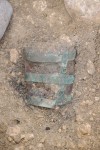 Initial osteological analysis confirmed that the burials include people of all ages and genders, with the exception of very young children. This could be the result of smaller, shallower graves having been disturbed over the centuries, or it could be a cultural practice. Infants and small children in antiquity and the early Middle Ages were sometimes buried within the boundaries of the home property rather than in the town cemetery.
Initial osteological analysis confirmed that the burials include people of all ages and genders, with the exception of very young children. This could be the result of smaller, shallower graves having been disturbed over the centuries, or it could be a cultural practice. Infants and small children in antiquity and the early Middle Ages were sometimes buried within the boundaries of the home property rather than in the town cemetery.
Archaeologists believe the necropolis was the cemetery of a small village. Burials ceased at the end of the 7th century and the cemetery was abandoned, probably in favor of new Christian cemeteries. In the 7th century a monastery was built on the site of the current church of Saint-Pierre Évrecy. It is likely to have had an associated cemetery that may have supplanted the former community burial ground.
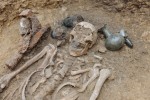 The necropolis is a very important find. There are no historical sources that refer to it and looters were blessedly unaware of its existence as well, leaving the grave goods in stellar condition and giving archaeologists the rare opportunity to study three centuries of undisturbed burials in context. This is a very thinly documented period of history, so the discovery is an invaluable resource.
The necropolis is a very important find. There are no historical sources that refer to it and looters were blessedly unaware of its existence as well, leaving the grave goods in stellar condition and giving archaeologists the rare opportunity to study three centuries of undisturbed burials in context. This is a very thinly documented period of history, so the discovery is an invaluable resource.
Archaeologists plan a comprehensive study the cemetery in the hope that it will illuminate the life of the community as well as the burial practices of the region during the transitional period between traditional Roman religion and Christian dominance.
